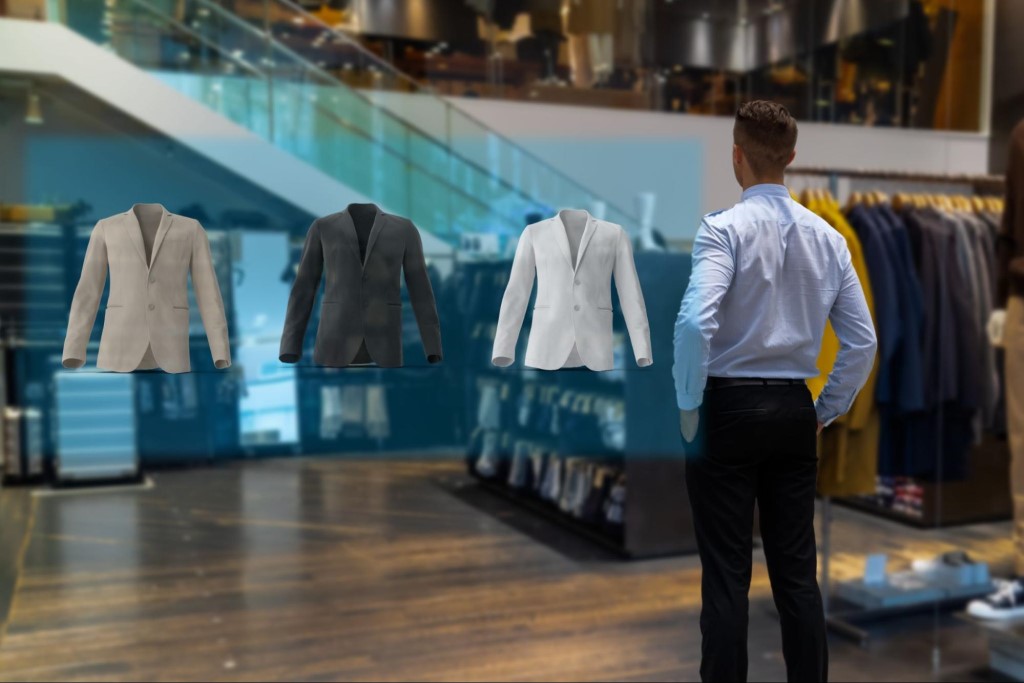
With augmented reality (AR) technology at its peak, we can’t overlook the billion-dollar fashion industry. Retailers can use augmented reality to find a balance between the physical and online fashion retail experiences, transform any room into a fitting room, and provide a practical option to customers’ sizing struggles.
AR opens up new possibilities for forward-thinking companies to get a glimpse into the future of fashion. A future that might be highly profitable if they recognize the patterns that are converging as our physical and digital lives become increasingly intertwined.
What is augmented reality, and how does it work?
Augmented reality is a 3D immersive technology that combines digital data with a user’s current physical environment. It overlays computer-generated visuals over a real-world scene, allowing you to change your vision of the world in real-time. Unlike a static image that is retroactively fitted in digital clothing, it interacts in the same way as Snapchat face filters do: when you move, the item keeps moving with you, responding to your movements, measurements, and environment in a realistic manner.
Fashion e-commerce, for example, can benefit greatly from augmented reality, since customers can see objects up close without having to travel to a store. Currently, AR-based solutions include:
- Virtual clothing try on technology
- Magic mirrors
- Virtual showrooms
- AR content
AR is now available for smartphones, and businesses are jumping on board to provide their customers with an unforgettable shopping experience. Customers can try on numerous new fashion outfits by projecting them at home using AR-based fashion apps like YourFit by 3DLOOK, and decide which ones they want to buy. Apps like this allow users to try on clothes by projecting visualization of clothes. So instead of relying on 2D images, YourFit enables users to dress up in digital clothing to discover how the product will fit their body shape.
Using augmented reality in the fashion industry has its advantages
Augmented reality technology provides convenience not just to customers, but also to manufacturers and business owners. It takes the shopping experience to the next level by allowing customers to try on products without having to touch or pay for them. The most significant benefit of having an augmented reality app for your fashion store is this.
As an online fashion retailer, you can use augmented reality technology to increase brand awareness and attract new customers, improve the customer experience for current clients, and encourage people to become brand ambassadors – all while increasing revenue and boosting profits.
We will take a closer look at some of the biggest advantages of AR for fashion e-commerce:
Brings in new customers
A creative and innovative augmented reality element is guaranteed to generate excitement around your brand, becoming a popular topic of conversation on social media and in industry news circles.
This is perfect for spreading the word about your business and products, as well as attracting new customers to your website without having to spend money on expensive acquisition strategies.
Increases customer engagement
Shoppers are hungry for immersive retail experiences like those offered by AR after months of store closures. Therefore, the immersive quality of AR will keep users glued to your site now more than ever.
By spending more time on your e-commerce store, customers gain a greater sense of loyalty to your brand, which increases their likelihood of making a purchase. According to Threekit, AR can maintain customers engaged for 2.7x longer, resulting in increased conversions, more sales, and the conversion of new clients into repeat customers.
Affects conversion rates
Augmented reality is proven to keep people on your site longer and give them a sense of confidence in your products, which is directly linked to increased sales. As per Shopify, interaction with a 3D model in augmented reality can boost product page conversion rates by up to 250%. With AR, customers get a unique, empowering experience that builds loyalty and enhances retention.
Provides customized fit
Personalization is a key element in your marketing arsenal in today’s competitive e-commerce market. Customers want to feel heard and appreciated. They want a purchasing experience that caters to their specific requirements. You can achieve this with the help of data from AR sessions.
Customers can use augmented reality clothing fitting to visualize various options for creating products that are tailored to their specific style, shape, and tastes. Based on the most recent IBM Watson data, with 75% of U.S. consumers viewing personalization as critical to a brand’s longevity, AR can assist brands in winning over modern consumers.
Reduces e-commerce returns
Ecommerce returns are expensive and troublesome and are one of the biggest problems online retailers face.
Returns hit fashion brands the hardest, with 30-40% of apparel and accessories purchased online being returned, frequently as a result of customers over-purchasing to try out other alternatives. This can have significant effects on a company’s profitability, not to mention the environmental impact.
AR solutions assisting innovative retailers
Various developments in emerging technologies are already helping businesses generate additional value, according to PWC. By 2030, immersive technologies are expected to boost global GDP by $1.5 trillion.
Currently, AR is changing the way people shop for clothes online. It’s a tried-and-true way to raise brand awareness, promote customer interaction, and drive sales, with a slew of advantages for both buyers and retailers.
Since more consumers demand a personalized shopping experience with integrated innovative solutions, AR technology is the optimal choice for the fashion industry. With technological advances moving at such a breakneck pace, we don’t have to wait too long to see the augmented reality fashion. So expect to see AR playing a far bigger part in e-commerce companies’ drive for clients and conversions in 2021, especially in light of rising online competition.